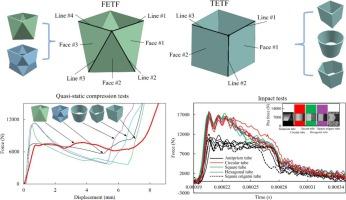Crashworthiness of antiprism thin-walled structures under quasi-static and dynamic loading
IF 7.9
2区 材料科学
Q1 MATERIALS SCIENCE, MULTIDISCIPLINARY
引用次数: 0
Abstract
This study explores the quasi-static and dynamic crushing behavior of a novel antiprism thin-walled structure designed to enhance energy absorption for crashworthiness applications. Unlike conventional cylindrical, polygonal, and origami-inspired tubes, which do not fully exploit wall folding to generate plastic hinges, the antiprism configuration promotes the formation and propagation of multiple plastic hinge lines, enabling stable progressive collapse and extended plateau stages. The structures were fabricated from 316L stainless steel using laser powder bed fusion and evaluated through quasi-static compression, Split Hopkinson Pressure Bar tests, and finite element simulations with the Johnson–Cook model. Compared with conventional counterparts of equal mass and thickness, the antiprism tubes achieved 6.4–14 % higher specific energy absorption (SEA), 7–79 % higher crushing force efficiency (CFE), and 7–68 % lower undesired load-carrying capacity (ULC). Under dynamic impact, they also exhibited the lowest initial peak crushing force. These results highlight the antiprism design as a lightweight and efficient solution for energy-absorbing components in sandwich panels and protective liners.

准静、动载荷下反棱柱薄壁结构的耐撞性
本研究探讨了一种新型反棱镜薄壁结构的准静态和动态破碎行为,该结构旨在增强抗碰撞应用的能量吸收。与传统的圆柱形、多边形和折纸管不同,这些管不能完全利用壁面折叠来产生塑料铰链,反棱镜结构促进了多个塑料铰链线的形成和传播,从而实现了稳定的渐进坍塌和延长的平台阶段。采用激光粉末床熔融法制备316L不锈钢结构,并通过准静态压缩、劈裂霍普金森压杆试验和Johnson-Cook模型有限元模拟对其进行评估。与同等质量和厚度的常规反棱镜管相比,反棱镜管的比能吸收(SEA)提高6.4 - 14%,破碎力效率(CFE)提高7 - 79%,非期望承载能力(ULC)降低7 - 68%。在动态冲击下,它们也表现出最低的初始峰值破碎力。这些结果突出了反棱镜设计是一种轻质和高效的解决方案,用于夹层板和保护衬垫中的吸能组件。
本文章由计算机程序翻译,如有差异,请以英文原文为准。
求助全文
约1分钟内获得全文
求助全文
来源期刊

Materials & Design
Engineering-Mechanical Engineering
CiteScore
14.30
自引率
7.10%
发文量
1028
审稿时长
85 days
期刊介绍:
Materials and Design is a multi-disciplinary journal that publishes original research reports, review articles, and express communications. The journal focuses on studying the structure and properties of inorganic and organic materials, advancements in synthesis, processing, characterization, and testing, the design of materials and engineering systems, and their applications in technology. It aims to bring together various aspects of materials science, engineering, physics, and chemistry.
The journal explores themes ranging from materials to design and aims to reveal the connections between natural and artificial materials, as well as experiment and modeling. Manuscripts submitted to Materials and Design should contain elements of discovery and surprise, as they often contribute new insights into the architecture and function of matter.
 求助内容:
求助内容: 应助结果提醒方式:
应助结果提醒方式:


